Ready to stain that old wood furniture? Start by disassembling pieces and cleaning off old finishes. Got gloves and a mask? You’ll need those! Make sure to pick a well-ventilated workspace—open those windows! Mix your stain shades to find the perfect color, and always test on a scrap piece first. Once you’re ready, apply it evenly, wipe off excess, and let it dry. Excited about giving your furniture a fresh look? Keep going to learn the finishing touches!
Key Takeaways
- Begin by cleaning the furniture thoroughly, removing old finishes and dust before starting the staining process.
- Disassemble the furniture for easier access and protection during staining, and use drop cloths to safeguard your workspace.
- Mix and test small amounts of stain on a scrap piece to achieve the desired color and consistency before application.
- Apply the stain using a microfiber pad or foam brush, ensuring even absorption and wiping off excess in the direction of the grain.
- Finish with a protective layer, like polyurethane, to lock in the stain’s color and enhance the furniture’s durability and appearance.
Preparation for Staining Wood Furniture
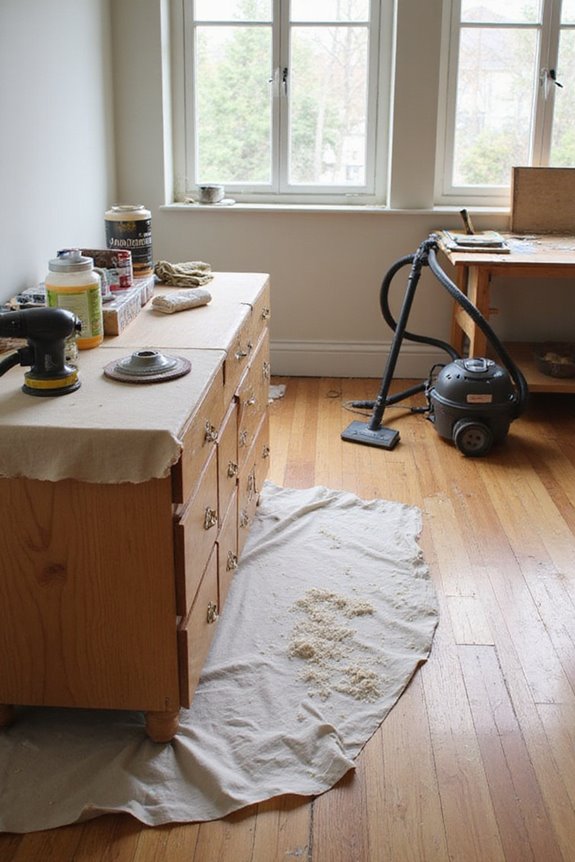
When you’re ready to stain your wood furniture, the first step is all about preparation! You’ll want to start with some solid cleaning techniques—remove old finishes and dust. Don’t forget to take apart your furniture for easier access! Protect your surroundings with drop cloths; trust me, your floors will thank you.
Now, let’s talk safety precautions! Grab some gloves and a mask to shield yourself from chemicals; your lungs will appreciate it. Gather your tools like sandpaper and brushes—having everything ready saves time later. Remember, a well-prepped piece leads to a stunning finish. Vintage storage benches, for instance, often require careful preparation to maintain their durability and appeal. So, are you excited? Let’s get that furniture looking fabulous!
Setting Up Your Workspace
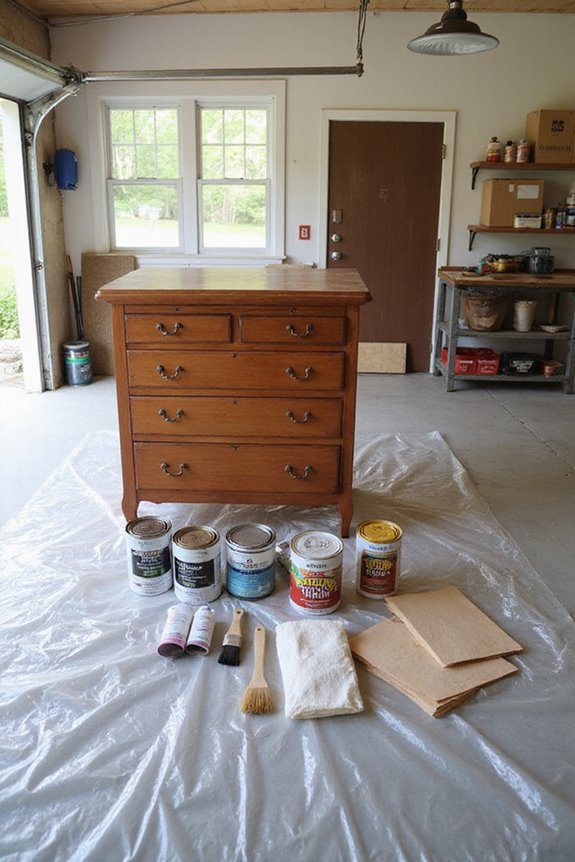
Now that you’ve prepped your wood furniture, it’s time to tackle setting up your workspace! First, pick a well-ventilated area. Open those windows or head outdoors for fresh air—trust me, your lungs will thank you! Next, let’s talk about your workspace layout. Lay down drop cloths to protect your floors from any sneaky spills. Keep everything clean and organized; a clutter-free space helps prevent accidents.
Don’t forget your safety precautions! Put on gloves, safety glasses, and maybe even a mask if those stains pack a punch. By setting up this way, you’ll have all your tools and materials ready, making your staining process smoother. Many woven baskets offer machine washable options, making cleaning up any accidental spills a breeze. Exciting, right? Let’s keep it fun and safe!
Mixing and Testing the Stain
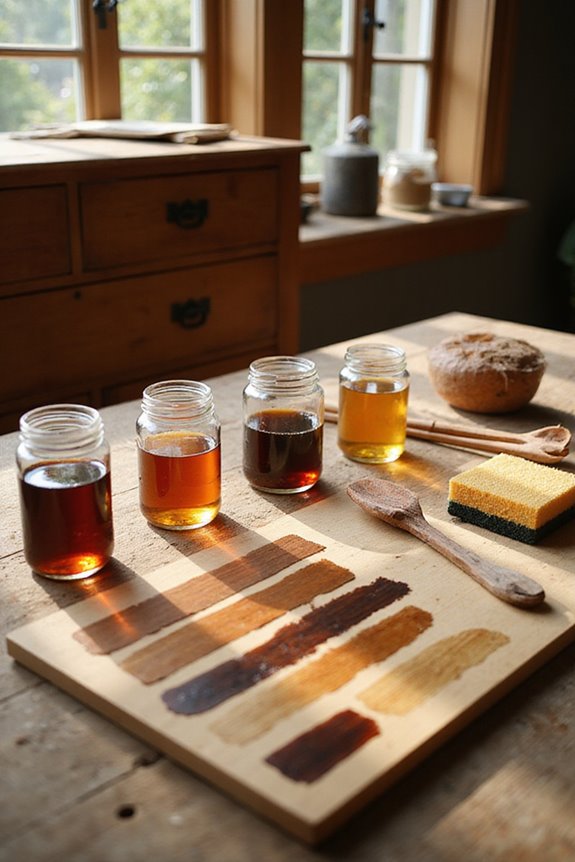
Before diving into staining your wood furniture, it’s essential to get your stain mixture just right! First, mix small amounts of stain to find that perfect custom color. You can combine different shades, but remember—stick to one brand to keep stain consistency. Have fun experimenting!
Use proper solvents to thin your stain if you want more transparency. Don’t forget to mix until all sediment is dissolved; no one likes chunky stain!
Once you’ve got your mix, test it on a scrap piece that matches your furniture. How does it look? Keep tweaking until you’re happy. Take notes on your proportions so you can recreate that glorious color later. Trust us, it’s worth the effort! Additionally, considering durable upholstery options can enhance the longevity of your furniture.
Application of Stain on Wood
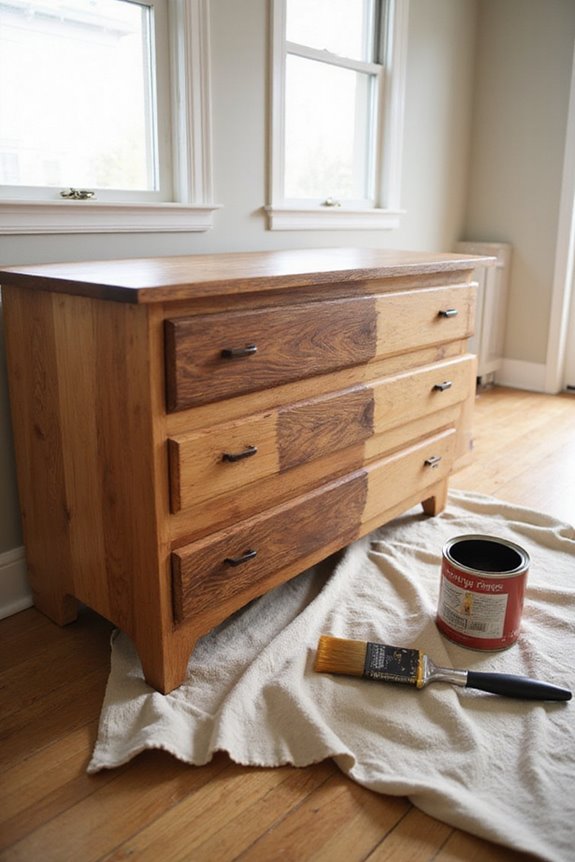
Ready to bring your wood furniture to life with a beautiful stain? First, stir the stain well so all those pigments are ready to work their magic! You’ll want to use a microfiber pad or foam brush, applying the stain in a circular motion. This helps with even stain absorption—no one wants blotchy spots, right?
Work in sections to avoid overwhelming the wood, and always wipe off excess stain in the grain’s direction. Do you have your clean rags handy? They’re a lifesaver for that! After you’ve stained, let it dry completely before moving on. Remember, patience is key! You’re creating something gorgeous here, so enjoy the process! Who knew staining could be so much fun?
Applying a Protective Finish
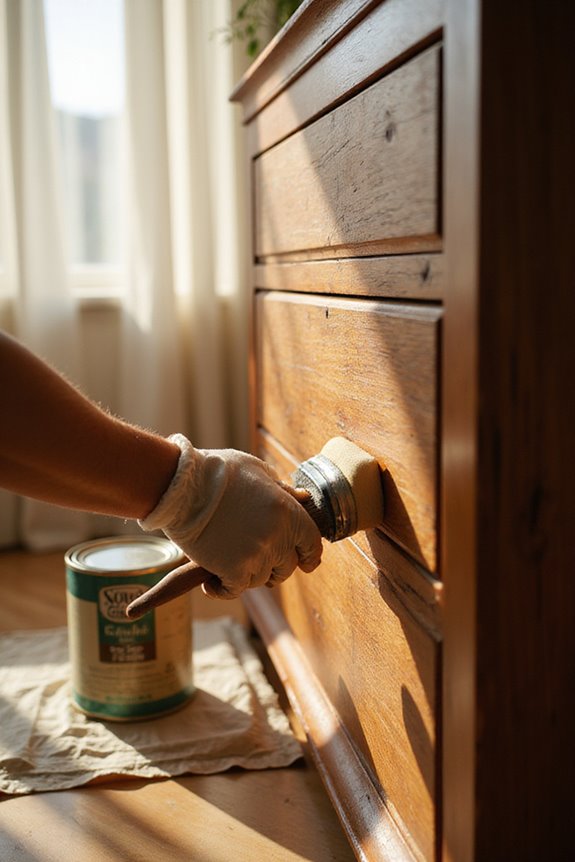
After you’ve put in all that effort to stain your wood furniture, it’s time to lock in that lovely color with a protective finish! Choosing the right finish type, like polyurethane for heavy-duty durability or wax for an easy application, makes a huge difference. You’ve got options, from water-resistant polyurethane to mellow shellac.
For application methods, think about using a sprayer for lacquer or a brush for shellac. Want something quick? Rollers work great for varnish on larger areas! Just remember, good ventilation is key during application. Got your gloves on? Perfect! Now, let’s make that furniture shine! With the right finish, you’ll not only protect your hard work but also give it a stunning look. Excited yet?
Frequently Asked Questions
Can I Stain Furniture Made From Manufactured Wood Products?
Imagine painting a canvas that feels smooth yet unyielding. You can stain manufactured wood, but you’ll need unique staining techniques. With patience and the right products, you can transform its surface into a beautiful masterpiece.
How Long Should I Wait Before Applying a Second Coat of Stain?
You should wait at least 1–10 hours before applying a second coat, depending on stain drying and application techniques. Always check the product label, as drying times can vary considerably between brands and types.
What Types of Stains Are Best for Outdoor Furniture?
For outdoor furniture, choose oil-based stains for durability and weather resistance on hardwoods, or water-based stains for softwoods. This guarantees your furniture looks great and withstands the elements over time, maintaining its appeal through seasons.
How Do I Remove Old Stain From Furniture?
Stubborn stain removal techniques start with safety; suit up for success. Next, furniture prep includes applying a chemical stripper, scraping, and washing. Repeat if needed, ensuring each step’s done properly for pristine results.
Can I Mix Different Stain Colors Together?
Yes, you can mix different stain colors together! Experiment with stain combinations through color blending to create unique shades. Just remember to test your mixture beforehand to guarantee you achieve the desired look on your wood.





